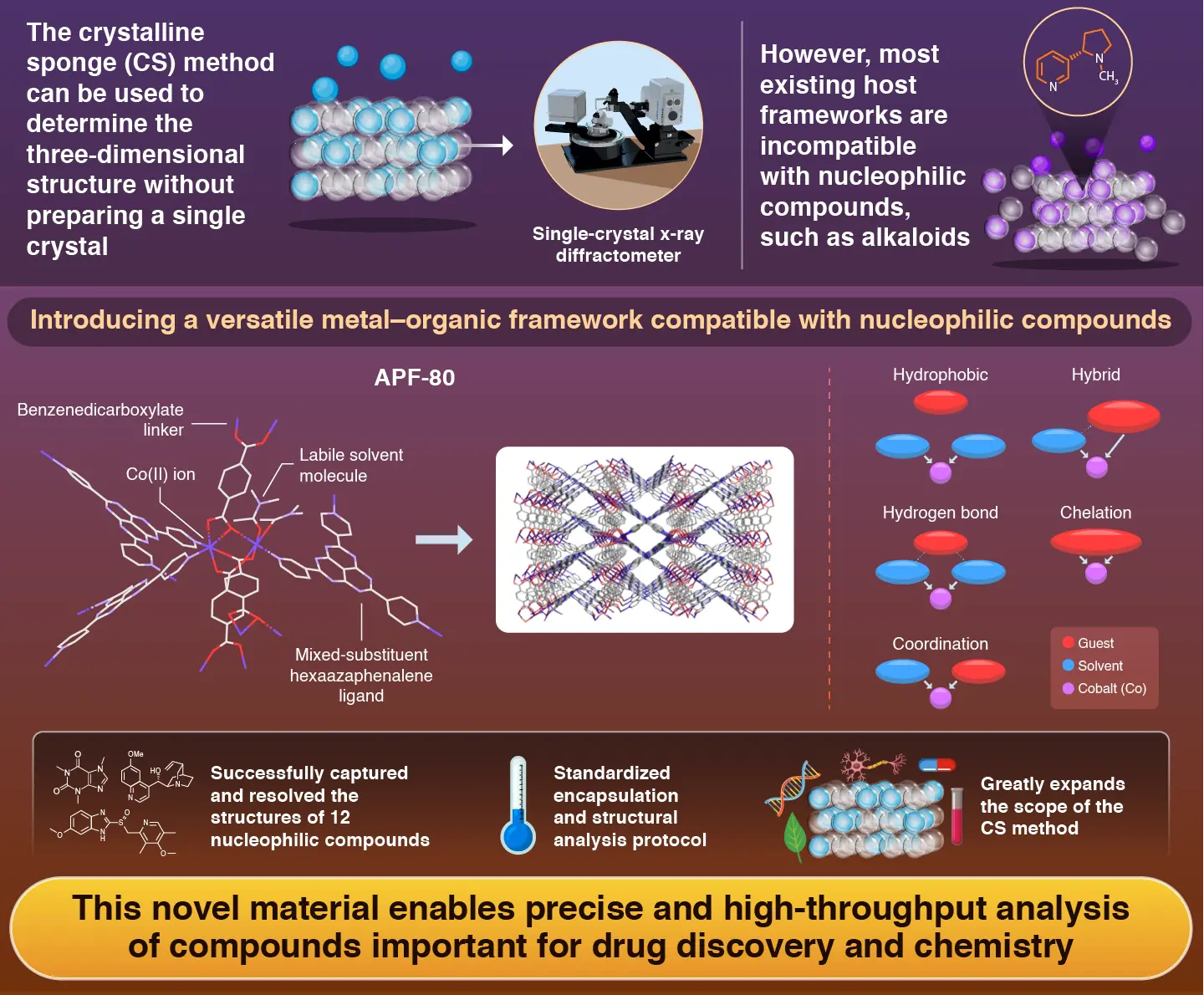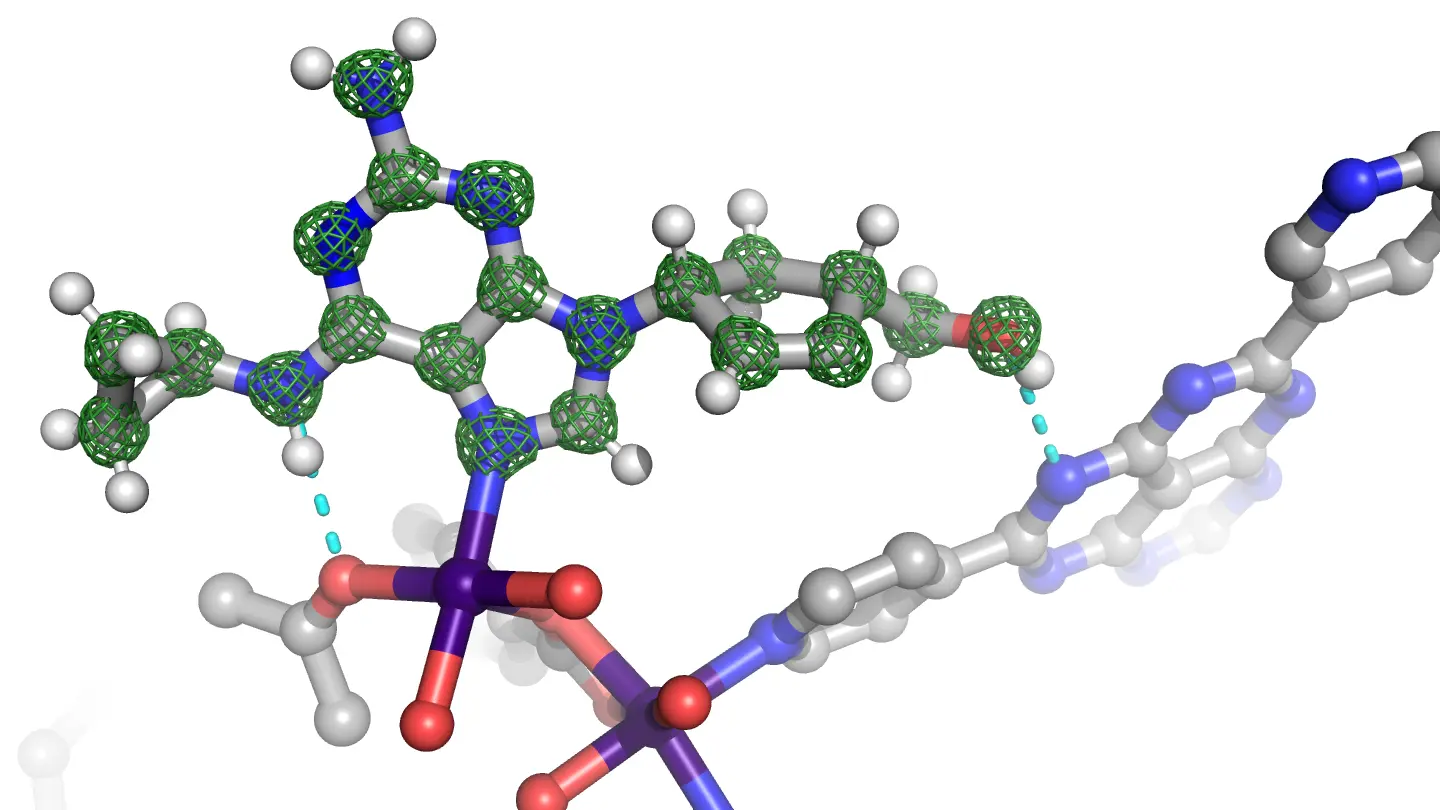Unlocking the structural analysis of alkaloids with a new metal–organic framework
Researchers develop a porous material that expands the applicability of the crystalline sponge method
A new metal–organic framework (MOF), APF-80, enables the crystalline sponge method to capture and analyze nucleophilic compounds. Alkaloids, a diverse group of biologically active compounds, usually damage MOF crystals and resist study. By incorporating multiple structural motifs, these guests are encapsulated inside APF-80, which allows high-quality crystallographic data collection. This development opens new possibilities for structural analysis, advancing drug development and biochemistry.
A New Tool for the Structural Characterization of Alkaloids

Nakagawa et al. (2025) | Journal of the American Chemical Society | 10.1021/jacs.5c07192
Alkaloids are a diverse family of naturally occurring compounds that contain nitrogen. Found in plants, animals, and microorganisms, they serve important roles in nature, such as defense and communication. Many alkaloids are well-known for their unique and powerful effects on living organisms even in minute quantities, making them immensely valuable for science and medicine. Some familiar examples include caffeine, nicotine, quinine, and morphine—substances that have shaped daily habits and lifesaving treatments alike.
Alkaloids often bear complex molecular structures featuring three-dimensional elements, and characterizing them is a challenging task. Molecular analysis techniques like X-ray diffraction require the target compound to be in crystal form. However, growing single crystal is a nontrivial task with no upper bound on time and effort. But what if we could impart crystalline order onto alkaloids using a carefully designed molecular framework, thus meeting the requirements of diffraction-based techniques?
In a recent study, a research team led by Professor Masaki Kawano and Assistant Professor Yuki Wada from the Department of Chemistry, School of Science at Institute of Science Tokyo, Japan, expanded the crystalline sponge (CS) method to make it compatible with alkaloids. Their work was made available online on July 31, 2025, and published in Volume 147, Issue 32 of the Journal of the American Chemical Society on August 13, 2025.
The CS technique is an innovative method introduced in 2013 that allows scientists to use diffraction-based analysis on molecules that are otherwise too difficult to crystallize on their own. Instead of growing crystals from the target compound, the method works by soaking the molecules into a crystalline porous framework that arranges them in a regular pattern via chemical interactions. Unfortunately, conventional CS frameworks are easily degraded by nucleophilic compounds, such as alkaloids, hindering their application for such molecules.
Against this backdrop, the research team developed a novel metal−organic framework (MOF), which they called APF-80. This MOF possesses several structural motifs that allows it to capture nucleophilic guests and immobilize them inside the pore while maintaining its structural integrity. “APF-80 features a hydrophilic pore environment and dual labile coordination sites, enabling the synergistic use of coordination bonds and hydrogen bonds to immobilize guest molecules,” explains Kawano.
Using APF-80, the researchers successfully captured and resolved the structures of 12 nucleophilic compounds using X-ray diffraction. These included naturally occurring alkaloids like caffeine and nicotine, pharmaceutical compounds such as omeprazole and abacavir, and a previously unreported intermediate.

From the obtained structures, the research team identified five distinct interaction types by which APF-80 captures and interacts with nucleophilic compounds. “The diverse interactivity inside APF-80 facilitated the effective accommodation of varied molecular shapes and functional groups, stabilizing their positions and orientations inside the pore,” highlights Wada, “These properties allowed us to obtain high-quality crystallographic data, which required minimal restraints or constraints to model.”
Thanks to this so-called ‘multimodal synergistic alignment’ mechanism, APF-80 will make it possible to apply the powerful CS technique to alkaloids and other nucleophilic molecules. With any luck, this work will pave the way for exciting discoveries in biochemistry, medicine, and food science.
Reference
- Authors:
- Tomoki Nakagawa1, Yuki Wada1,2*, Bun Chan3, Taichi Baba1, Kengo Hanaya4, Yuta Koseki5, Ryuji Asano5, Katsuyuki Aoki5, Pavel M. Usov1, and Masaki Kawano1,2*
- Title:
- Structural Elucidation of Nucleophilic Compounds through Synergistic Coordination and Hydrogen Bonding in a Metal–Organic Framework
- Journal:
- Journal of the American Chemical Society
- DOI:
- 10.1021/jacs.5c07192
- Affiliations:
- 1Department of Chemistry, School of Science, Institute of Science Tokyo, Japan
2TEKMOF Co., Ltd., Japan
3Graduate School of Engineering, Nagasaki University, Japan
4Faculty of Pharmacy, Keio University, Japan
5Tsumura Botanical Raw Materials Research Laboratories, Tsumura & Co, Japan
Related articles
Further Information
Professor Masaki Kawano
Department of Chemistry, School of Science, Institute of Science Tokyo
Contact
Public Relations Division, Institute of Science Tokyo
- Tel
- +81-3-5734-2975
- media@adm.isct.ac.jp